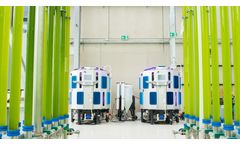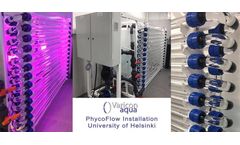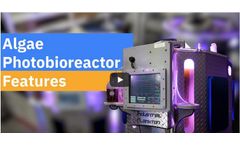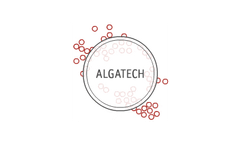Photobioreactor Articles & Analysis
18 articles found
The results are extremely detrimental, shaving off both the longevity and daily yields of the large-scale culture.Enter Industrial Plankton’s Photobioreactors (PBRs) Our bioreactors, complete with automated control of vital parameters, are optimized for producing a reliable and biosecure inoculum for massive systems. ...
Varicon Aqua’s latest project is up and running in Hong Kong, with the installation led in person by our Managing Director, Joe McDonald. The client, Geb Impact Technology Company Limited, will be using two of our reactor systems, the Phyco-Lift and the Phyco-Pyxis, the latest in our range of innovative products. Geb Impact and Varicon Aqua have enjoyed a long professional relationship, ...
As such, they are particularly cognisant of the importance of maintaining a healthy, stable and fast growing Spirulina culture. The Phyco-Flow photobioreactor will aid them in this process by providing a closed, controllable and fully automated production platform. To conclude, we would like to thank Algae Bulgaria for choosing to contract with us, and we wish them all the best ...
We are delighted to have completed our latest 12,000 L Phyco-Flow photobioreactor installation for Algaecytes UK. This Phyco-Flow is the most recent example of our multi photo-stage photobioreactor, designed specifically for industrial scale production of microalgae. ...
Furthermore, the interconnected modular design enables scale-up without the performance drop normally associated with the scale up of many alternative types of photobioreactor. Other design benefits include low shear and high mass transfer culturing conditions. ...
We recently installed 4 x 70L capacity Phyco-Lift, airlift photobioreactors utilisng Schott Glass components. Incorporating a full suite of controls with data acquisition and controllable, dimmable LED lighting, sterile dry air drives the systems with CO2 injection for pH control. ...
The latest image a pair of 2 x 7000 L Phyco-Flow photobioreactor systems. Each with full process control, cooling, shading, data acquisition, remote access, automated harvesting and downstream processing. ...
Researchers will use the tubular photobioreactor, situated on the Lahti campus (Faculty of Biological and Environmental Sciences), to cultivate microalgae in support of their on-going projects. ...
We are pleased to announce the latest installation of a 2750 L Phyco-Flow system for Grupo Fagro at their new Micro Algae Technology Development Unit, Biorganix in Ramos Arizpe, Mexico in conjunction with Novel Agricultural Bioactives from Microalgae (NAMBA) initiative. Our Phyco-Flow tubular photo-bioreactor will be used to cultivate microalgae species for the production of synthetic ...
Many of these design innovations find their way into the next generation of our PBR systems, making our Phyco-range of photobioreactor systems among the best in class. Our customers have also expressed their satisfaction with the supporting and advisory role we play in many research endeavors where we implement an honest and direct approach to consultation. ...
Algae bioreactors (PBR) Features – Easy algae cultivation Traditional algal culture techniques are unreliable and labour & space-intensive. Our photobioreactors make algae growth simple by automating routine tasks. Algae grows incredibly dense in our PBRs’ custom-designed high surface area sealed tank and it stays clean as everything entering the PBr is ...
The two broadest methods of culturing algae at medium to large scale are split into two styles of system: open and closed photobioreactors (PBRs). A PBR is any device or system that supports the culture of photosynthetic organisms using light. There are photobioreactor advantages and disadvantages to both types systems depending on the goals you have for ...
Industrial Plankton’s photobioreactors make business easier for companies around the world. And they are located in Victoria! ...
Over the past two decades, the Company has grown to become one of the world's largest photobioreactor facilities, and a leading biotech business in the nutraceuticals sector. ...
ByAlgatech
Several obstacles and limitations currently prevent the industrial exploitation of microalgae for feed, food and biofuel production. Photobioreactors (closed systems for algae cultivation) suffer from high-energy expenditures for mixing and cooling, while cultures in large-scale open ponds, which have a more favorable net energy ratio, are unstable ecosystems in which maintaining ...
The paper reports the results of an experiment to assess the feasibility of including a photobioreactor within the design of a wastewater treatment plant, growing microalgae on the centrate from anaerobic sludge dewatering. ...
Chlorellais one of the few microalgae employed for human consumption. It typically has a high protein content, but it can also accumulate high amounts of lipids or carbohydrates under stress conditions and, for this reason, it is of interest in the production of biofuels. High production costs and energy consumption are associated with its cultivation. This work describes a strategy to reduce ...
In this study, a novel optical panel photobioreactor (OPPBR) equipped with a V-cut/or flat optical panel (OP) and a light source, i.e., light-emitting diodes (LEDs) was developed. ...








